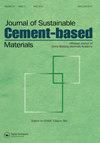Low carbon technology roadmap of China cement industry
IF 4.2
3区 工程技术
Q1 CONSTRUCTION & BUILDING TECHNOLOGY
Journal of Sustainable Cement-Based Materials
Pub Date : 2023-03-30
DOI:10.1080/21650373.2023.2188274
引用次数: 1
Abstract
China announced the goal of carbon peaking by 2035 and carbon neutral by 2060. In 2020, the carbon emission of cement production was 1.32 billion tons, accounting for about 80% of the total carbon emission of building materials in China. The carbon emission of cement production mainly comes from the clinker production. The key to cut emission is to reduce the consumption of fossil energy and limestone. The major measures include energy efficiency improvement, alternative fuel usage, raw material substitution, and new low-carbon cement clinker production technology. This paper illustrates the effect of low carbon technologies application and the carbon reducing potential from this period to 2060. It is predicted that when carbon neutral goal would be achieved by 2060, the carbon reduction from energy efficiency improvement, alternative fuels usage, alternative raw materials usage, low-carbon cement and CCUS technology would be 8%, 4%, 27%, 28% and 33%, respectively. Meanwhile, the 13% of CO2 related with cement producing would be used to curing cement-based materials.中国水泥工业低碳技术路线图
中国宣布了到2035年实现碳达峰、到2060年实现碳中和的的目标。2020年,水泥生产碳排放13.2亿吨,约占中国建材碳排放总量的80%。水泥生产的碳排放主要来自熟料生产。减少排放的关键是减少化石能源和石灰石的消耗。主要措施包括提高能源效率、替代燃料使用、原料替代和新的低碳水泥熟料生产技术。本文阐述了从这一时期到2060年低碳技术应用的效果和减碳潜力。据预测,到2060年实现碳中和的目标时,能源效率提高、替代燃料使用、替代原材料使用、低碳水泥和CCUS技术的碳减排率分别为8%、4%、27%、28%和33%。同时,与水泥生产相关的13%的二氧化碳将用于固化水泥基材料。
本文章由计算机程序翻译,如有差异,请以英文原文为准。
求助全文
约1分钟内获得全文
求助全文
来源期刊
CiteScore
6.60
自引率
15.90%
发文量
71
期刊介绍:
The Journal of Sustainable Cement-Based Materials aims to publish theoretical and applied researches on materials, products and structures that incorporate cement. The journal is a forum for discussion of research on manufacture, hydration and performance of cement-based materials; novel experimental techniques; the latest analytical and modelling methods; the examination and the diagnosis of real cement and concrete structures; and the potential for improved cement-based materials. The journal welcomes original research papers, major reviews, rapid communications and selected conference papers. The Journal of Sustainable Cement-Based Materials covers a wide range of topics within its subject category, including but are not limited to: • raw materials and manufacture of cement • mixing, rheology and hydration • admixtures • structural characteristics and performance of cement-based materials • characterisation techniques and modeling • use of fibre in cement based-materials • degradation and repair of cement-based materials • novel testing techniques and applications • waste management

 求助内容:
求助内容: 应助结果提醒方式:
应助结果提醒方式:


